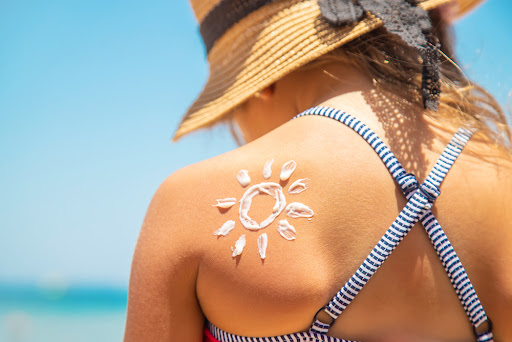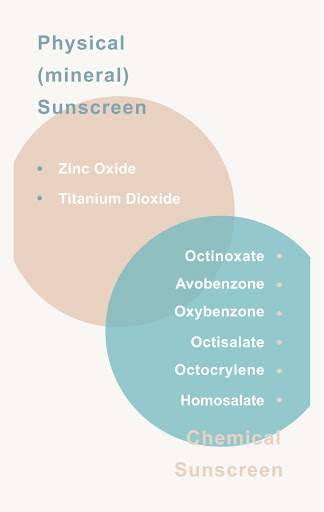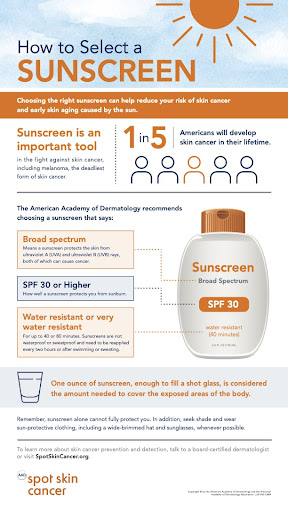 Hold on while we scare you with some facts from the American Academy of Dermatology (AAD):
Hold on while we scare you with some facts from the American Academy of Dermatology (AAD):
- Skin cancer is the most common cancer in the U.S.
- 1 in 5 Americans will develop skin cancer in their lifetime.
- 20 Americans die from melanoma every day.
However, SKIN CANCER IS ALSO ONE OF THE MOST PREVENTABLE CANCERS!
Yes! Skin cancer is preventable! As are some of the signs of aging caused by the sun. All you need to do is protect your precious skin, and an effective way to do that is to wear sunscreen.
You’ve heard us say it a million times…here’s one more: Wear your sunscreen! Make it a part of your daily skincare routine. Even when you think that you’re safe because of an overcast day, 80% of the sun’s cancer-causing rays are still getting through to your skin.
Now, we’re going to stop with the scary and turn up the helpful. When protecting your skin, there are two main types of sunscreen out there: chemical and mineral (physical) sunscreen. And it turns out that the one you choose can make a huge difference, both in your body and on the environment.
Armed with a little extra knowledge about your sunscreen, we hope you’ll feel confident shielding your skin from the sun’s rays. We’ll break it all down for you, starting with what chemical and mineral (physical) sunscreens are and the differences between them. Followed by the benefits of mineral sunscreen (clearly our favorite). And ending with some guidelines on how to properly use sunscreen. Here we go!
What are the two kinds of sunscreen?
Some sunscreen is always better than none, but not all sunscreens are the same.
Chemical Sunscreen
According to the AAD, “chemical sunscreens work like a sponge, absorbing the sun’s rays.” Then, there is a chemical reaction that neutralizes the harmful rays and expels heat as a byproduct. Your skin will actively absorb this type of sunscreen and its non-natural ingredients, which can include oxybenzone, octinoxate, octocrylene, avobenzone, octisalate, and homosalate. None of these ingredients have been declared GRASE (Generally recognized as safe and effective) by the FDA, which is still doing research on their safety. However, chemical sunscreen is easier to rub into your skin and doesn’t typically leave a visible residue.
Mineral Sunscreen
Mineral or physical sunscreens sit on the surface of the skin and “act like a shield” reflecting the sun’s rays. They will typically contain zinc oxide, titanium oxide, or both, and many will also have iron oxide which protects against the visible blue light from computers and devices. Mineral sunscreen is wonderful for those with sensitive skin. Though mineral sunscreen is known for leaving a visible, pale residue, many companies now offer a “tinted” version that negates the issue.
What are the differences between chemical and mineral sunscreens?
The main difference between chemical and mineral (physical) sunscreens is in their blocking method. Where chemical sunscreens absorb the UVs, react with them, and expel them as heat, mineral (physical) sunscreens deflect the sun’s rays.
Additionally, chemical sunscreens are absorbed into the skin, whereas mineral sunscreens sit on top. That means that chemical sunscreens are more likely to irritate the skin, and their ingredients are present in the body, often for long periods of time. This becomes a particularly relevant issue when you are following a strict skincare routine and applying your sunscreen daily.
Chemical and mineral sunscreens also vary greatly in their ingredients. Chemical sunscreens use several different ingredients that may not be safe and could have lasting effects. Some studies have shown that a concentration of oxybenzone and octinoxate in the body can lead to hormone imbalances which cause difficulties with development and reproduction. Mineral sunscreens, however, contain natural, safe ingredients (zinc oxide, titanium dioxide) that have been labeled GRASE by the U.S. Food & Drug Administration (FDA).
A minor difference between the two is their ease of application. Some people don’t want to use mineral sunscreen because it can tend to leave a white residue, however, as stated above, there are now “tinted” mineral sunscreens to avoid this effect.
What are the benefits of mineral sunscreen?
With chemical sunscreens, your skin is absorbing a range of chemicals that will stay in your body for an extended period of time and may cause hormone disruptions that can affect reproduction and development. Because of the skin absorption, it can also cause skin irritation and allergic reaction.
Mineral sunscreen, however, is comprised of two natural ingredients: zinc oxide and titanium dioxide. This type of protection sits on top of the skin, it is not absorbed, making it better for sensitive skin. Additionally, it works immediately after application to reflect the sun’s rays.
A major plus to using mineral sunscreen is that it is environmentally friendly. Oxybenzone and octinoxate, which enter the water when your sunscreen washes off in the ocean, are known to kill coral reefs. In fact, chemical sunscreens are banned in several countries, including parts of the U.S. (see this article in Condé Nast Traveler for more information on where and why). Wearing mineral sunscreen can keep your mind at ease, knowing that you are doing the right thing for your skincare, your body, and your part for the environment.
How to properly apply sunscreen:
 The key to defense against the rays is proper tools and technique!
The key to defense against the rays is proper tools and technique!
- Start with the proper sunscreen. It should have an SPF of 30 or higher, be water-resistant, and provide broad-spectrum coverage. Broad-spectrum means that it protects against UVA and UVB rays. If it doesn’t specifically say “broad-spectrum,” then it is probably simply an SPF and only protects against UVB, which causes burning. UVA rays are responsible for long-term damage: wrinkles and premature aging.
- Apply before you go out in the sun. If you’re using a chemical sunscreen, it needs to absorb into the skin before sun exposure. Apply 15-30 minutes beforehand. Mineral sunscreen, however, is ready to protect upon application!
- Apply at least 1 oz (for the average adult) to cover your entire body.
- Apply everywhere not covered by clothing. Hair thinning? Get your scalp, too.
- Use an SPF lip balm.
- Reapply every two hours or after sweating or swimming.
Remember, sunscreen helps protect the skin by preventing sunburn, minimizing signs of aging, and reducing your risk of skin cancer. However, sunscreen isn’t your only line of defense.
- Stay in shady areas between the hours of 10 am and 2 pm.
- Dress in a wide-brimmed hat and long sleeves and pants to cover as much vulnerable skin as possible.
Take care of your skin!
No matter what, take care of your skin! Integrate an appropriate sunscreen into your daily skincare routine, preferably a mineral (physical) sunscreen. Skin cancer is prevalent and can be deadly, but it can also be prevented. Take these simple steps and enjoy the warm weather on the way!
Our recommendation!
We adore Colorscience®’s line of mineral sunscreen products, especially their Sunforgettable Total Protection Face Shield, Sunforgettable Total Protection Sports Stick, Sunforgettable Total Protection Body Shield, and Sunforgettable Total Protection Brush-on Shield. If you have any questions about Colorscience® products and what they can do for your skincare routine, contact us! And when ordering from our website through the end of April, get 25% off your order with the promo code SKIN25.
Skincare at Lincoln’s Advanced Skin + Body Aesthetics!
Advanced Skin + Body Aesthetics is the place to go for skin care and facials in Lincoln, NE, and the surrounding area! Contact us to make an appointment today for a consultation with one of our licensed aestheticians.
We are devoted to helping you look as good as you feel using the latest technology and pride ourselves on staying on the cutting edge of Lincoln skincare and aesthetics.
If you are looking for a med spa in Lincoln, NE, Advanced Skin + Body Aesthetics has everything you’re looking for. Learn more about how to look and feel your best with our body and skincare blog. Talk to yourself in a positive way with The Power of Positive Self-Affirmations and take care of the curtains on the windows of your soul with Caring for Your Eyebrows!
